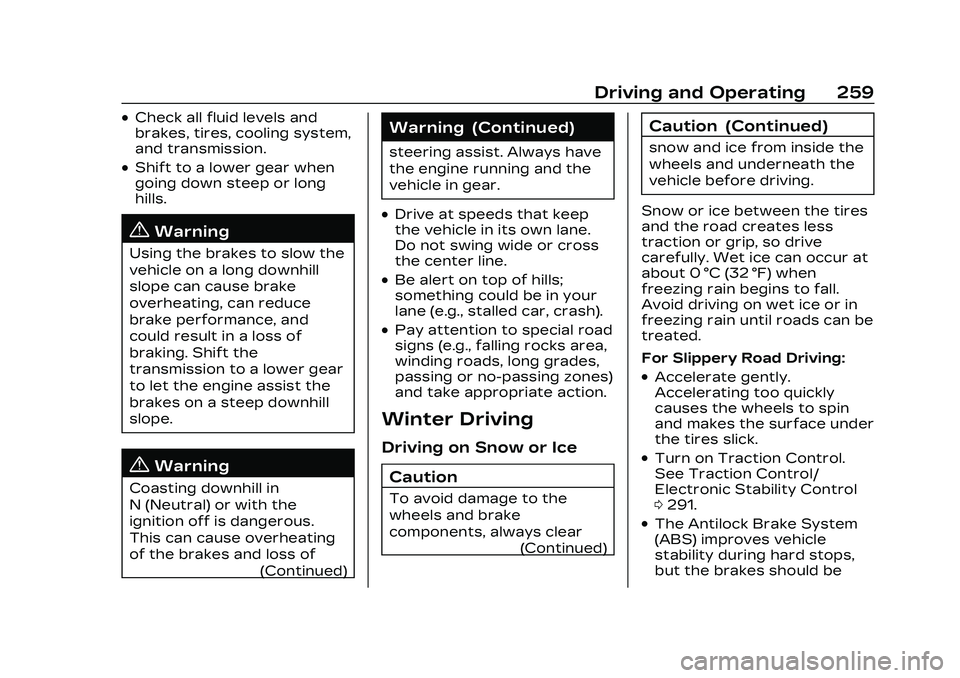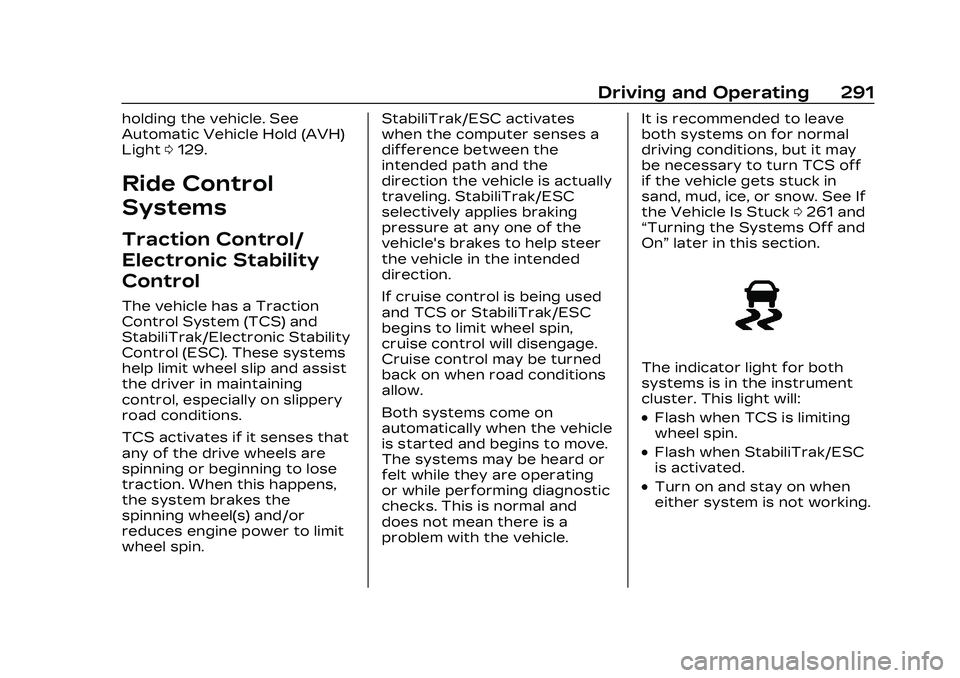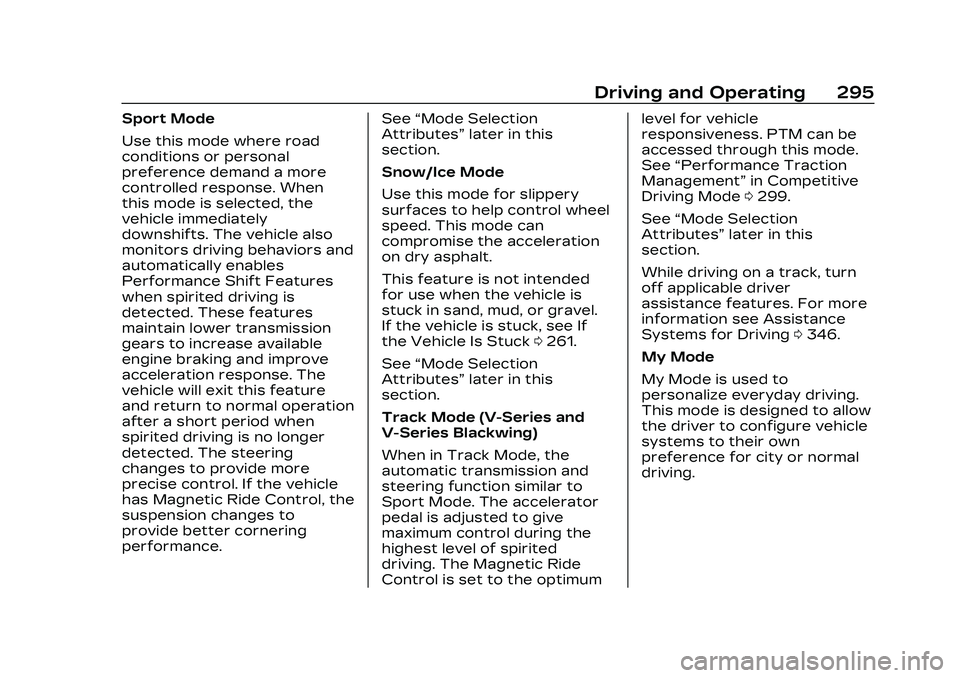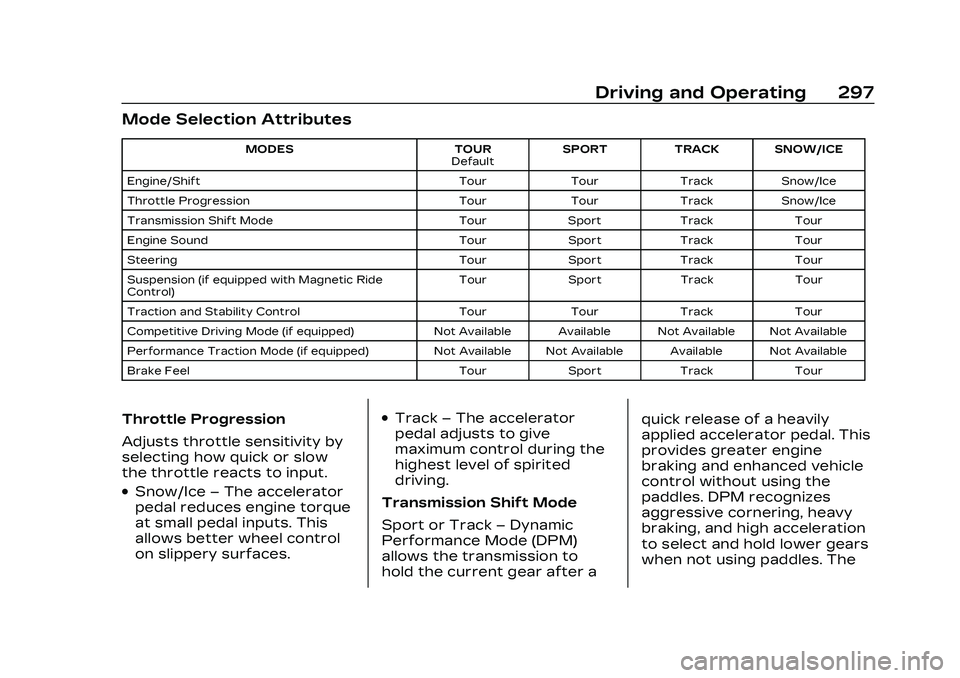traction control CADILLAC CT5 2023 Owner's Manual
[x] Cancel search | Manufacturer: CADILLAC, Model Year: 2023, Model line: CT5, Model: CADILLAC CT5 2023Pages: 526, PDF Size: 6.85 MB
Page 260 of 526

Cadillac CT5 Owner Manual (GMNA-Localizing-U.S./Canada-16500419) -
2023 - CRC - 5/10/22
Driving and Operating 259
.Check all fluid levels and
brakes, tires, cooling system,
and transmission.
.Shift to a lower gear when
going down steep or long
hills.
{Warning
Using the brakes to slow the
vehicle on a long downhill
slope can cause brake
overheating, can reduce
brake performance, and
could result in a loss of
braking. Shift the
transmission to a lower gear
to let the engine assist the
brakes on a steep downhill
slope.
{Warning
Coasting downhill in
N (Neutral) or with the
ignition off is dangerous.
This can cause overheating
of the brakes and loss of(Continued)
Warning (Continued)
steering assist. Always have
the engine running and the
vehicle in gear.
.Drive at speeds that keep
the vehicle in its own lane.
Do not swing wide or cross
the center line.
.Be alert on top of hills;
something could be in your
lane (e.g., stalled car, crash).
.Pay attention to special road
signs (e.g., falling rocks area,
winding roads, long grades,
passing or no-passing zones)
and take appropriate action.
Winter Driving
Driving on Snow or Ice
Caution
To avoid damage to the
wheels and brake
components, always clear (Continued)
Caution (Continued)
snow and ice from inside the
wheels and underneath the
vehicle before driving.
Snow or ice between the tires
and the road creates less
traction or grip, so drive
carefully. Wet ice can occur at
about 0 °C (32 °F) when
freezing rain begins to fall.
Avoid driving on wet ice or in
freezing rain until roads can be
treated.
For Slippery Road Driving:
.Accelerate gently.
Accelerating too quickly
causes the wheels to spin
and makes the surface under
the tires slick.
.Turn on Traction Control.
See Traction Control/
Electronic Stability Control
0 291.
.The Antilock Brake System
(ABS) improves vehicle
stability during hard stops,
but the brakes should be
Page 262 of 526

Cadillac CT5 Owner Manual (GMNA-Localizing-U.S./Canada-16500419) -
2023 - CRC - 5/10/22
Driving and Operating 261
To save fuel, run the engine
for short periods to warm the
vehicle and then shut the
engine off and partially close
the window. Moving about to
keep warm also helps.
If it takes time for help to
arrive, when running the
engine, push the accelerator
pedal slightly so the engine
runs faster than the idle
speed. This keeps the battery
charged to restart the vehicle
and to signal for help with the
headlamps. Do this as little as
possible, to save fuel.
If the Vehicle Is Stuck
Slowly and cautiously spin the
wheels to free the vehicle
when stuck in sand, mud, ice,
or snow.
The Traction Control System
(TCS) can often help to free a
stuck vehicle. See Traction
Control/Electronic Stability
Control0291. If TCS cannot free the vehicle,
turn TCS off and use the
rocking method. See
“Rocking
the Vehicle to Get it Out”
following.
{Warning
If the vehicle's tires spin at
high speed, they can
explode, and you or others
could be injured. The vehicle
can overheat, causing an
engine compartment fire or
other damage. Spin the
wheels as little as possible
and avoid going above
56 km/h (35 mph).
Rocking the Vehicle to Get
it Out
Turn the steering wheel left
and right to clear the area
around the front wheels. Turn
off any traction system. Shift
back and forth between
R (Reverse) and a low forward
gear, spinning the wheels as
little as possible. To prevent
transmission wear, wait until the wheels stop spinning
before shifting gears. Release
the accelerator pedal while
shifting, and press lightly on
the accelerator pedal when
the transmission is in gear.
Slowly spinning the wheels in
the forward and reverse
directions causes a rocking
motion that could free the
vehicle. If that does not get
the vehicle out after a few
tries, it might need to be
towed out. If the vehicle does
need to be towed out, see
Transporting a Disabled
Vehicle
0455.
Vehicle Load Limits
It is very important to know
how much weight the
vehicle can carry. This
weight is called the vehicle
capacity weight and
includes the weight of all
occupants, cargo, and all
nonfactory-installed
options. Two labels on the
vehicle may show how
Page 292 of 526

Cadillac CT5 Owner Manual (GMNA-Localizing-U.S./Canada-16500419) -
2023 - CRC - 5/10/22
Driving and Operating 291
holding the vehicle. See
Automatic Vehicle Hold (AVH)
Light0129.
Ride Control
Systems
Traction Control/
Electronic Stability
Control
The vehicle has a Traction
Control System (TCS) and
StabiliTrak/Electronic Stability
Control (ESC). These systems
help limit wheel slip and assist
the driver in maintaining
control, especially on slippery
road conditions.
TCS activates if it senses that
any of the drive wheels are
spinning or beginning to lose
traction. When this happens,
the system brakes the
spinning wheel(s) and/or
reduces engine power to limit
wheel spin. StabiliTrak/ESC activates
when the computer senses a
difference between the
intended path and the
direction the vehicle is actually
traveling. StabiliTrak/ESC
selectively applies braking
pressure at any one of the
vehicle's brakes to help steer
the vehicle in the intended
direction.
If cruise control is being used
and TCS or StabiliTrak/ESC
begins to limit wheel spin,
cruise control will disengage.
Cruise control may be turned
back on when road conditions
allow.
Both systems come on
automatically when the vehicle
is started and begins to move.
The systems may be heard or
felt while they are operating
or while performing diagnostic
checks. This is normal and
does not mean there is a
problem with the vehicle.
It is recommended to leave
both systems on for normal
driving conditions, but it may
be necessary to turn TCS off
if the vehicle gets stuck in
sand, mud, ice, or snow. See If
the Vehicle Is Stuck
0261 and
“Turning the Systems Off and
On” later in this section.
The indicator light for both
systems is in the instrument
cluster. This light will:
.Flash when TCS is limiting
wheel spin.
.Flash when StabiliTrak/ESC
is activated.
.Turn on and stay on when
either system is not working.
Page 293 of 526

Cadillac CT5 Owner Manual (GMNA-Localizing-U.S./Canada-16500419) -
2023 - CRC - 5/10/22
292 Driving and Operating
If either system fails to turn on
or to activate, a message may
display in the Driver
Information Center (DIC), and
dcomes on and stays on to
indicate that the system is
inactive and is not assisting
the driver in maintaining
control. The vehicle is safe to
drive, but driving should be
adjusted accordingly.
If
dcomes on and stays on:
1. Stop the vehicle.
2. Turn the engine off and wait 15 seconds.
3. Start the engine.
Drive the vehicle. if
dcomes
on and stays on, the vehicle
may need more time to
diagnose the problem. If the
condition persists, see your
dealer.
Turning the Systems Off
and On
Caution
Do not repeatedly brake or
accelerate heavily when TCS
is off. The vehicle driveline
could be damaged.
To turn off only TCS, press
and release
g. The traction off
light
idisplays in the
instrument cluster. A DIC
message may display. To turn TCS on again, press
and release
g. The traction off
light
idisplayed in the
instrument cluster will turn off.
If TCS is limiting wheel spin
when
gis pressed, the system
will not turn off until the
wheels stop spinning.
To turn off both TCS and
StabiliTrak/ESC, press and
hold
guntil the traction off
light
iand StabiliTrak/ESC
OFF light
gcome on and stay
on in the instrument cluster.
A DIC message may display.
To turn TCS and StabiliTrak/
ESC on again, press and
release
g. The traction off
light
iand StabiliTrak/ESC
OFF light
gin the instrument
cluster turn off.
Adding accessories can affect
the vehicle's performance. See
Accessories and Modifications
0 374.
Page 296 of 526

Cadillac CT5 Owner Manual (GMNA-Localizing-U.S./Canada-16500419) -
2023 - CRC - 5/10/22
Driving and Operating 295
Sport Mode
Use this mode where road
conditions or personal
preference demand a more
controlled response. When
this mode is selected, the
vehicle immediately
downshifts. The vehicle also
monitors driving behaviors and
automatically enables
Performance Shift Features
when spirited driving is
detected. These features
maintain lower transmission
gears to increase available
engine braking and improve
acceleration response. The
vehicle will exit this feature
and return to normal operation
after a short period when
spirited driving is no longer
detected. The steering
changes to provide more
precise control. If the vehicle
has Magnetic Ride Control, the
suspension changes to
provide better cornering
performance.See
“Mode Selection
Attributes” later in this
section.
Snow/Ice Mode
Use this mode for slippery
surfaces to help control wheel
speed. This mode can
compromise the acceleration
on dry asphalt.
This feature is not intended
for use when the vehicle is
stuck in sand, mud, or gravel.
If the vehicle is stuck, see If
the Vehicle Is Stuck 0261.
See “Mode Selection
Attributes” later in this
section.
Track Mode (V-Series and
V-Series Blackwing)
When in Track Mode, the
automatic transmission and
steering function similar to
Sport Mode. The accelerator
pedal is adjusted to give
maximum control during the
highest level of spirited
driving. The Magnetic Ride
Control is set to the optimum level for vehicle
responsiveness. PTM can be
accessed through this mode.
See
“Performance Traction
Management” in Competitive
Driving Mode 0299.
See “Mode Selection
Attributes” later in this
section.
While driving on a track, turn
off applicable driver
assistance features. For more
information see Assistance
Systems for Driving 0346.
My Mode
My Mode is used to
personalize everyday driving.
This mode is designed to allow
the driver to configure vehicle
systems to their own
preference for city or normal
driving.
Page 298 of 526

Cadillac CT5 Owner Manual (GMNA-Localizing-U.S./Canada-16500419) -
2023 - CRC - 5/10/22
Driving and Operating 297
Mode Selection Attributes
MODESTOUR
Default SPORT
TRACK SNOW/ICE
Engine/Shift TourTourTrackSnow/Ice
Throttle Progression TourTourTrackSnow/Ice
Transmission Shift Mode TourSport Track Tour
Engine Sound TourSport Track Tour
Steering TourSport Track Tour
Suspension (if equipped with Magnetic Ride
Control) Tour
Sport Track Tour
Traction and Stability Control TourTourTrack Tour
Competitive Driving Mode (if equipped) Not Available Available Not Available Not Available
Performance Traction Mode (if equipped) Not Available Not Available Available Not Available
Brake Feel TourSport Track Tour
Throttle Progression
Adjusts throttle sensitivity by
selecting how quick or slow
the throttle reacts to input.
.Snow/Ice–The accelerator
pedal reduces engine torque
at small pedal inputs. This
allows better wheel control
on slippery surfaces.
.Track –The accelerator
pedal adjusts to give
maximum control during the
highest level of spirited
driving.
Transmission Shift Mode
Sport or Track –Dynamic
Performance Mode (DPM)
allows the transmission to
hold the current gear after a quick release of a heavily
applied accelerator pedal. This
provides greater engine
braking and enhanced vehicle
control without using the
paddles. DPM recognizes
aggressive cornering, heavy
braking, and high acceleration
to select and hold lower gears
when not using paddles. The
Page 300 of 526

Cadillac CT5 Owner Manual (GMNA-Localizing-U.S./Canada-16500419) -
2023 - CRC - 5/10/22
Driving and Operating 299
Engine/Shift
Engine/Shift adjusts the
throttle response, gear
shifting and engine
performance. Throttle
response increases in the
Sport, Track, and Snow/Ice
settings, and gear shifting is
more aggressive.
–Snow/Ice, Tour, Sport, Track
Engine Sound
Engine sound adjusts the
volume of engine noise. The
settings range from quietest
to loudest volume from
Stealth through Track.
–Stealth, Tour, Sport, Track
PTM (If Equipped)
PTM controls vehicle
performance systems for
professional handling on race
tracks. Traction Control and
Stability Control are reduced
when moving through each of
the settings. Changing PTM
settings may also
automatically change theother subsystem settings.
While driving on a track, turn
off all active safety features.
While driving on a track, turn
off applicable driver
assistance features. For more
information, see Assistance
Systems for Driving
0346. For
more information on PTM, see
Competitive Driving Mode
0 299.
–Off, Wet, Dry, Sport, Race 1,
Race 2
Competitive
Driving Mode
To select this optional
handling mode, place the
vehicle in Sport Mode and
press
gtwo times and the
Driver Information Center
(DIC) will display
COMPETITIVE MODE ON.
While in the Competitive
Driving Mode, the traction off
light
iand StabiliTrak/ESC
OFF light
gwill come on in the
instrument cluster. Traction
Control System (TCS) does not limit wheel spin, the
Electronic Limited-Slip
Differential (eLSD) allows
increased vehicle agility, and
more effort is required to turn
the steering wheel. See
“Limited-Slip Differential
(V–Series Only)”
later in this
section. Adjust your driving
accordingly.
Press
gagain, or turn the
vehicle to accessory mode and
restart the vehicle, to turn
TCS back on. The traction off
light
iand StabiliTrak/ESC
OFF light
gwill go out.
Caution
When traction control is
turned off, or Competitive
Driving Mode is active, it is
possible to lose traction.
Performance Traction
Management (PTM)
If equipped, PTM can be
activated through V-Mode
customization or by pressing
Page 302 of 526

Cadillac CT5 Owner Manual (GMNA-Localizing-U.S./Canada-16500419) -
2023 - CRC - 5/10/22
Driving and Operating 301
SPORT
.For use by drivers who are
familiar with the track.
.Dry conditions only.
.Requires more driving skill
than DRY.
.StabiliTrak/ESC is on and
more engine power is
available than in DRY.
RACE 1
.For use by drivers who are
familiar with the track.
.Dry conditions only.
.Requires more driving skill
than modes DRY or SPORT.
.StabiliTrak/ESC is off and
available engine power is the
same as SPORT.
RACE 2
.For use by experienced
drivers who are familiar with
the track.
.Dry conditions only.
.Requires more driving skill
than in other modes.
.StabiliTrak/ESC is off and
engine power is available for
maximum cornering speed.
In any PTM Mode, Launch
Control is available. Use PTM
Race 2 for the most
consistent performance
during drag strip use. See
“Custom Launch Control” in
Track Events and Competitive
Driving (V-Series and V-Series
Blackwing) 0246.
Launch Control
If equipped, Launch Control is
available within Competitive
Driving Mode and PTM to
allow high levels of vehicle
acceleration in a straight line.
Launch Control is a form of
traction control that manages
tire spin while launching the
vehicle. This feature is
intended for use during closed
course race events where
consistent zero to
60 and quarter mile times are
desirable. Launch Control is only
available when the following
criteria are met:
.Competitive Driving Mode is
selected or any of the PTM
modes are selected. The
traction off light comes on in
the instrument cluster and
the appropriate DIC
message displays.
.The vehicle is not moving.
.The steering wheel is
pointing straight.
Automatic Transmissions
.The brake pedal is firmly
pressed to the floor,
equivalent to a panic brake
event.
.The accelerator pedal is
rapidly applied to wide open
throttle. If the vehicle rolls
due to wide open throttle,
release the throttle, press
the brake pedal more firmly,
and reapply the accelerator
to wide open throttle.
Page 303 of 526

Cadillac CT5 Owner Manual (GMNA-Localizing-U.S./Canada-16500419) -
2023 - CRC - 5/10/22
302 Driving and Operating
Launch Control will initially
limit engine speed as you
rapidly apply the accelerator
pedal to wide open throttle.
Allow the engine rpm to
stabilize. A smooth, quick
release of the brake pedal,
while maintaining the fully
pressed accelerator pedal, will
manage wheel slip.
After the vehicle is launched,
the system continues in
Competitive Driving Mode
or PTM.
Competitive Driving Mode,
PTM, and Launch Control are
systems designed for a closed
course race track and not
intended for public roads. The
systems are not intended to
compensate for lack of driver
experience or familiarity with
the race track.Limited-Slip
Differential
If equipped, the Electronic
Limited-Slip Differential (eLSD)
is automatically activated.
eLSD actively monitors vehicle
sensors and driver inputs to
determine the amount of
change for the conditions.
With eLSD, the vehicle has:
.Enhanced high-speed
control.
.Improved traction through
corners, allowing more
acceleration.
.More precise steering.
.Increased vehicle agility.
.Integration with StabiliTrak/
Electronic Stability
Control (ESC).
For vehicles with eLSD, driven
under severe conditions, the
rear axle fluid should be
changed. See Competitive
Driving Mode 0299 and
Maintenance Schedule 0471.
Cruise Control
{
Warning
Cruise control can be
dangerous where you
cannot drive safely at a
steady speed. Do not use
cruise control on winding
roads or in heavy traffic.
Cruise control can be
dangerous on slippery roads.
On such roads, fast changes
in tire traction can cause
excessive wheel slip, and
you could lose control. Do
not use cruise control on
slippery roads.
With cruise control, a speed of
about 40 km/h (25 mph) or
more can be maintained
without keeping your foot on
the accelerator. Cruise control
does not work at speeds
below about 40 km/h (25 mph).
If equipped with a manual
transmission, the cruise
control will remain active when
Page 304 of 526

Cadillac CT5 Owner Manual (GMNA-Localizing-U.S./Canada-16500419) -
2023 - CRC - 5/10/22
Driving and Operating 303
the gears are shifted. The
cruise is disengaged if the
clutch is pressed for several
seconds.
If the Traction Control/
StabiliTrak/Electronic Stability
Control (ESC) system begins
to limit wheel spin while using
cruise control, the cruise
control automatically
disengages. See Traction
Control/Electronic Stability
Control0291. If a collision
alert occurs when cruise
control is activated, cruise
control is disengaged. See
Forward Collision Alert (FCA)
System 0346. When road
conditions allow cruise control
to be safely used, it can be
turned back on.
Cruise control will disengage if
either TCS or StabiliTrak/ESC
is turned off.
If the brakes are applied,
cruise control disengages.
J: Press to turn the system
on and off. A white indicator
appears in the instrument
cluster when cruise is
turned on.
RES+ : If there is a set speed
in memory, press briefly to
resume to that speed or press
and hold to accelerate. If the
cruise control is already active,
use to increase vehicle speed.
To increase speed by 1 km/h
(1 mph), press RES+ to the first
detent. To increase speed to
the next 5 km/h (5 mph) mark
on the speedometer, press
RES+ to the second detent. SET−
:Press briefly to set the
speed and activate cruise
control. If the cruise control is
already active, use to
decrease vehicle speed. To
decrease speed by 1 km/h
(1 mph), press SET− to the first
detent. To decrease speed to
the next 5 km/h (5 mph) mark
on the speedometer, press
SET− to the second detent.
*:Press to disengage cruise
control without erasing the
set speed from memory.
Setting Cruise Control
If
Jis on when not in use,
SET− or RES+ could get
pressed and go into cruise
when not desired. Keep
Joff
when cruise is not being used.
1. Press
J.
2. Get up to the desired speed.
3. Press and release SET−. The desired set speed
briefly appears in the
instrument cluster.